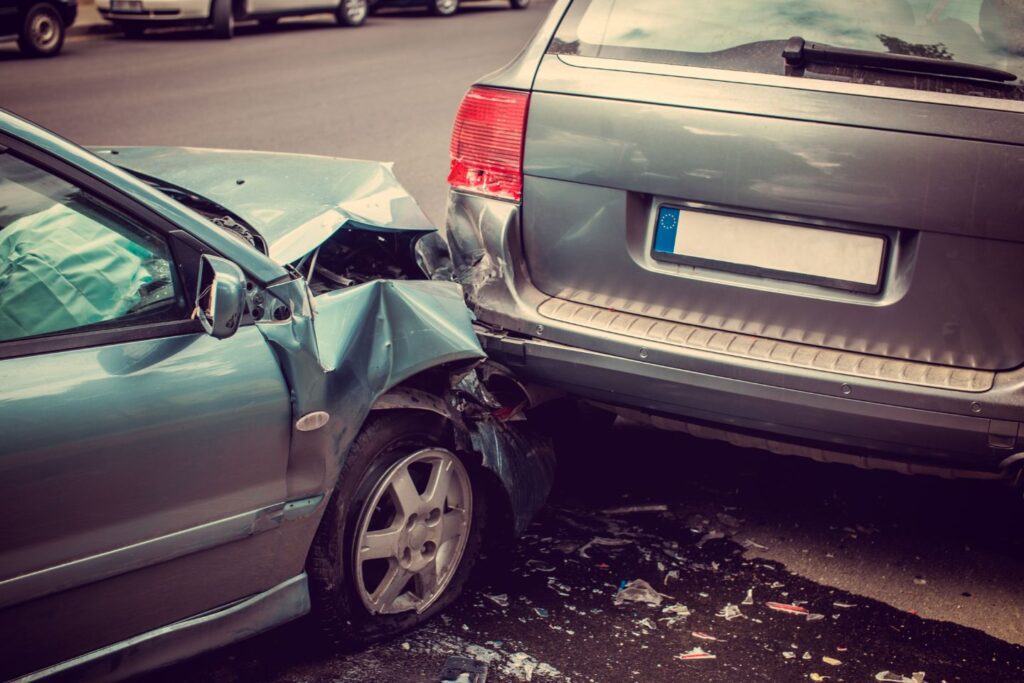Santa Maria’s roads are more dangerous than many realize. According to 2021 OTS Ratings, this city ranks alarmingly high at 5th out of 60 cities of comparable size for fatal and injury crashes. Each number in this ranking is a story of disruption, challenge, and the need for informed guidance and support.
Navigating the aftermath of a Santa Maria car accident involves several critical steps to ensure your safety, protect your legal rights, and secure your financial future.
This article aims to offer valuable insights into your legal rights and recovery process.
Potential Risks of Car Accidents in Santa Maria
Santa Maria’s roads, while bustling with daily activity, present significant risks to drivers, passengers, and pedestrians alike.
Key factors contributing to these risks are not just about vehicle numbers, but also about specific behaviors and conditions on the road. According to the OTS report, certain categories of accidents are particularly prevalent in the area.
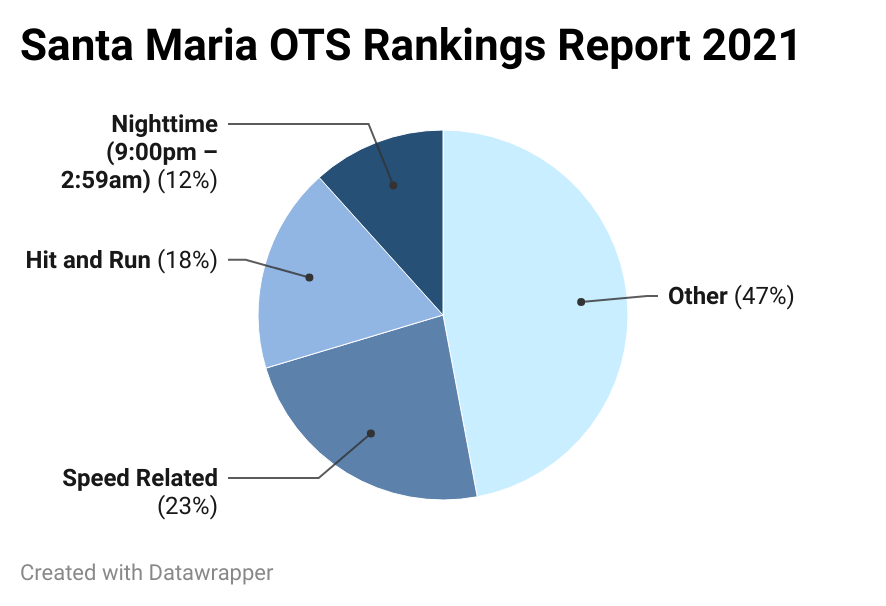

- Speed-Related Accidents: Santa Maria ranks 1st out of 60 cities of comparable size for speed-related crashes. This top ranking underscores the severity of speeding as a factor in road safety, emphasizing the need for drivers to strictly follow speed limits.
- Nighttime Driving Risks: The risks on the road escalate after dark, with Santa Maria ranking 4th for accidents during the hours of 9:00 pm to 2:59 am. This position points to the critical dangers of limited visibility and driver alertness at night, highlighting the importance of extra caution during these hours.
- Hit-and-run Run Incidents: In the category of hit-and-run incidents, Santa Maria is again ranked 1st. This indicates the broader issue of driver accountability and poses risks for victims trying to get legal help and financial compensation.
What to do Immediately After a Car Accident in Santa Maria?
Experiencing a car accident can be stressful. However, taking the right steps immediately afterward is crucial for your safety, legal rights, and potential compensation.
Here’s what to do if you find yourself in this unfortunate situation:
- Safety First: Check for any injuries to yourself or passengers. If anyone is hurt, try to remain calm and do not move them unless there’s an immediate danger, as this could exacerbate their injuries.
- Call 911: It’s vital to report the accident to the authorities. Calling 911 will dispatch emergency services to your location and the Santa Maria Police Department will create an official accident report – a critical document if you later seek legal advice or compensation.
- Document the Scene: If you’re able to do so safely, take photographs of the accident scene, including all vehicles involved, any injuries, and road conditions. This visual evidence can be invaluable later on.
- Exchange Information: Gather names, contact information, insurance details, and vehicle registration numbers from all parties involved. Be polite, but avoid discussing fault or liability at the scene.
- Witness Details: If there are witnesses, ask for their contact information. Their accounts may prove essential in piecing together how the accident occurred.
- Seek Medical Attention: Even if you feel fine, it’s important to get a medical evaluation as soon as possible. Some injuries, like whiplash or concussions, might not be immediately apparent.
- Notify Your Insurance: Contact your insurance company to report the accident, but avoid making any official statements or accepting settlement offers without consulting a legal expert.
Navigating Legal Steps After a Car Accident in Santa Maria
After a car accident in Santa Maria, it’s essential to know when legal action may be necessary. Understanding your legal rights and the laws that protect you will guide you through this process.
Here’s what you need to consider:
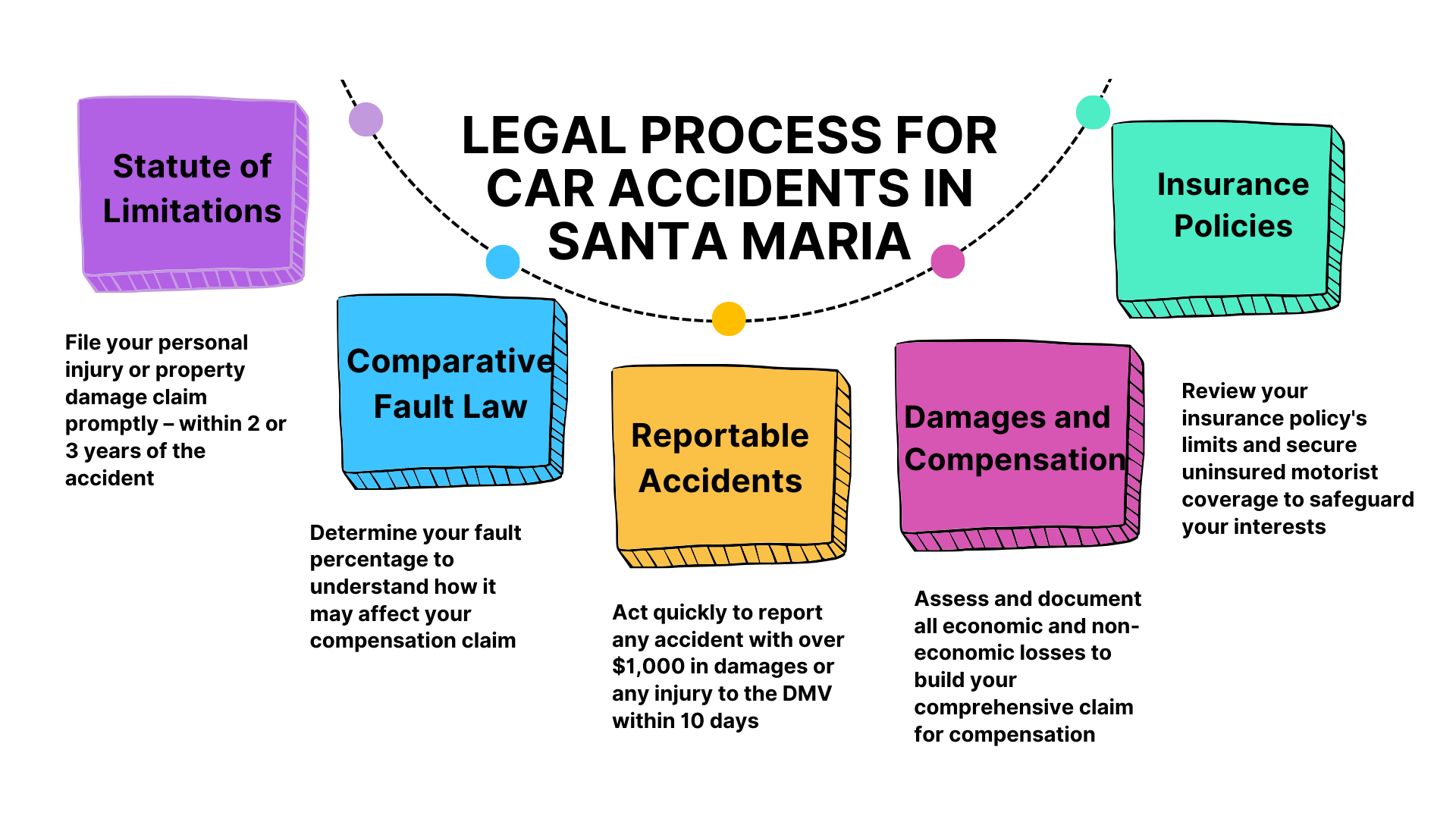

Statute of Limitations
When you’re involved in a Santa Maria car accident, the timing of your legal actions is crucial due to the statute of limitations set by California law. This law defines the specific periods within which you must initiate a lawsuit to seek damages resulting from a car accident.
- Personal Injury Claims: According to California Civil Code Section 335.1, for personal injuries resulting from a car accident, you have a two-year window from the date of the accident to initiate legal proceedings. This statute of limitations is crucial because it allows sufficient time for the full extent of your injuries to become apparent and to be properly assessed.
- Property Damage Claims: In cases of property damage, such as harm to your vehicle, the California Code of Civil Procedure Section 338 provides a three-year statute of limitations from the date of the accident. This timeframe allows you to assess the extent of the damage and proceed with a lawsuit if necessary.
It’s crucial to understand that these legal windows are immovable. If you try to file a lawsuit after the statute of limitations has expired, your case will almost certainly be dismissed, and you’ll lose the opportunity to seek compensation.
California’s Comparative Fault Law
In the aftermath of a car accident in Santa Maria, it’s crucial to understand California’s comparative fault law, formally known as “pure comparative negligence.” This law, outlined in California Civil Code Section 1431.2, plays a vital role when multiple parties contribute to an accident.
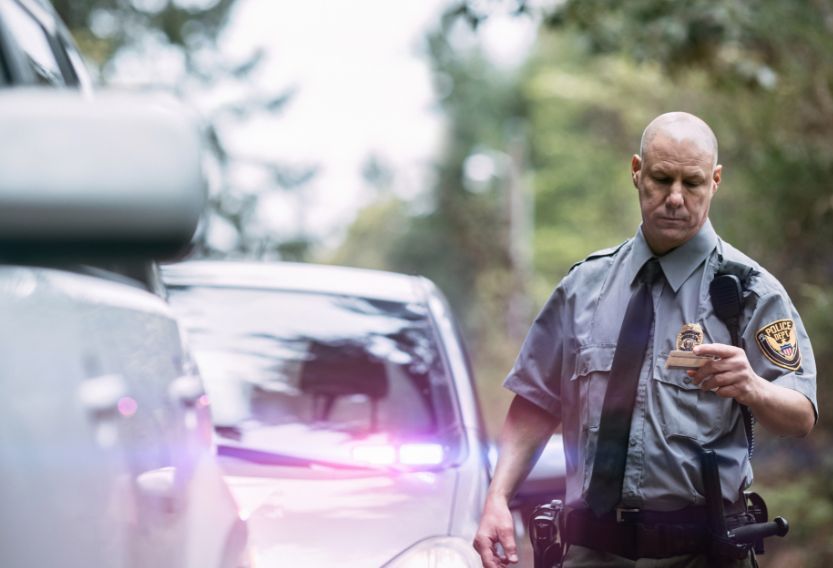

Here’s a breakdown of what “pure comparative negligence” entails:
- Shared Fault: Under this law, if an accident occurs and both parties are at fault, compensation is allocated based on the level of fault assigned to each party. This means that each party’s financial responsibility is proportional to their share of the blame.
- Compensation Reduction: Your compensation can be adjusted to reflect your share of the fault. For instance, if you are deemed 30% responsible for an accident with total damages of $100,000, your potential recovery would be reduced by 30%, entitling you to $70,000.
- No-Fault Barrier: California’s approach is more lenient compared to some states that disallow recovery if you are more than 50% or 51% at fault. In California, you can seek damages even if you are predominantly at fault (up to 99%), but your compensation will be significantly reduced according to your percentage of fault.
Reportable Accidents
California law mandates that any accident resulting in injury, death, or property damage exceeding $1,000 must be reported to the Department of Motor Vehicles (DMV). This report is separate from any reports made to law enforcement at the scene of the accident and is required within 10 days of the incident.
This legal requirement serves several purposes. It ensures that the DMV has a complete record of all traffic incidents, which can affect driving privileges and insurance. Moreover, it’s a protective measure for those involved in the accident. Without this official documentation, you could face challenges when seeking compensation or when dealing with insurance claims. Timely reporting also prevents potential legal penalties that could affect your driving record and rights.
Seeking Damages and Compensation
A car accident might leave you facing a range of financial, physical, and emotional hardships. Understanding what damages you’re entitled to claim is a critical step in your recovery process. Damages in a car accident case can be broadly categorized into two types: economic and non-economic damages.
Economic Damages
These are quantifiable financial losses that result from the accident. They include medical bills for both immediate and ongoing treatments, costs of rehabilitation, lost wages if you’re unable to work due to your injuries, and any potential loss of future earning capacity. Economic damages also cover the costs of repairing or replacing your vehicle and any other property damage.
Non-Economic Damages
These are more subjective and include compensation for pain and suffering, emotional distress, loss of enjoyment of life, and loss of companionship. Though harder to quantify, these damages recognize the profound impact an accident can have on your quality of life.
Punitive Damages
In rare cases, the court might award punitive damages if the at-fault party’s actions were reckless or malicious. These damages are not about paying the victim back, but about sending a strong message that dangerous or intentionally harmful actions will have serious consequences.
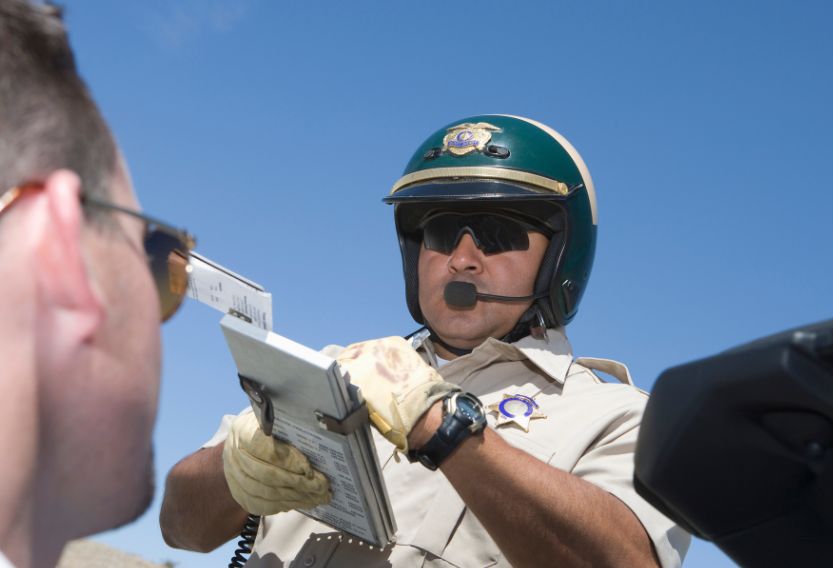

Insurance Considerations
When contemplating legal action following a car accident in Santa Maria, understanding the role of insurance is key. Insurance issues can significantly influence the decision to pursue legal proceedings.
Here’s what to consider:
- Policy Limits and Coverage: When another party is at fault in an accident, their insurance policy’s coverage becomes a critical factor. Be aware that these policies have maximum limits, which might not cover all your losses, particularly in severe accidents. This is why it’s essential to review the at-fault party’s insurance details early on, as it sets the stage for the compensation you might receive.
- Dealing with Insurers: Insurance companies often prioritize settling claims quickly and economically. It’s common for initial settlement offers to be lower than what you might actually need or deserve. It’s advisable to approach these offers with caution and consider consulting a legal expert before accepting them.
- Your Own Insurance: If the at-fault driver is uninsured or underinsured, your own insurance policy might have provisions for such situations. Understanding your policy’s uninsured motorist coverage is important.
- Dispute Resolution: When there’s disagreement over who’s at fault or how much a claim is worth, having legal support becomes crucial. Lawyers can effectively negotiate with insurance companies and, if necessary, take the matter to court. Their involvement often leads to a more serious consideration of your claims and a fairer assessment of damages.
- Subrogation Rights: Sometimes, your insurance company might pay your expenses upfront and then seek reimbursement from the at-fault party’s insurer. Understanding these subrogation rights is important in the context of a legal claim.
In navigating these complex insurance waters, having a knowledgeable ally can make all the difference. At The Personal Injury Center, we connect you with expert personal injury lawyers who can advocate on your behalf to ensure you receive the compensation you deserve. Contact us today to explore how we can assist you in your post-accident journey.
Preventative Measures When Driving in Santa Maria
Driving safely in Santa Maria is about being proactive in preventing accidents. Here are some key preventative measures to keep in mind:
- Adhere to Speed Limits: Santa Maria’s speed limits are enforced to maximize safety. Remember, speed-related accidents are a significant concern in the area. Following these limits is not just a legal obligation but a crucial step in preventing accidents.
- Avoid Distracted Driving: California law strictly prohibits texting and the use of handheld devices while driving (California Vehicle Code Section 23123.5). Keeping your full attention on the road reduces the risk of accidents significantly.
- Stay Alert at Night: Given the higher incidence of accidents during nighttime hours, extra caution after dark is essential. Ensure your vehicle’s lights are functioning correctly and be extra vigilant for pedestrians and other hazards.
- Never Drive Under the Influence: DUI laws in California are stringent (California Vehicle Code Section 23152). Driving under the influence of alcohol or drugs not only increases the risk of causing an accident but also carries severe legal consequences.
- Regular Vehicle Maintenance: Keeping your vehicle in good working condition is vital. Regular checks, especially of brakes and tires, can prevent accidents caused by mechanical failures.
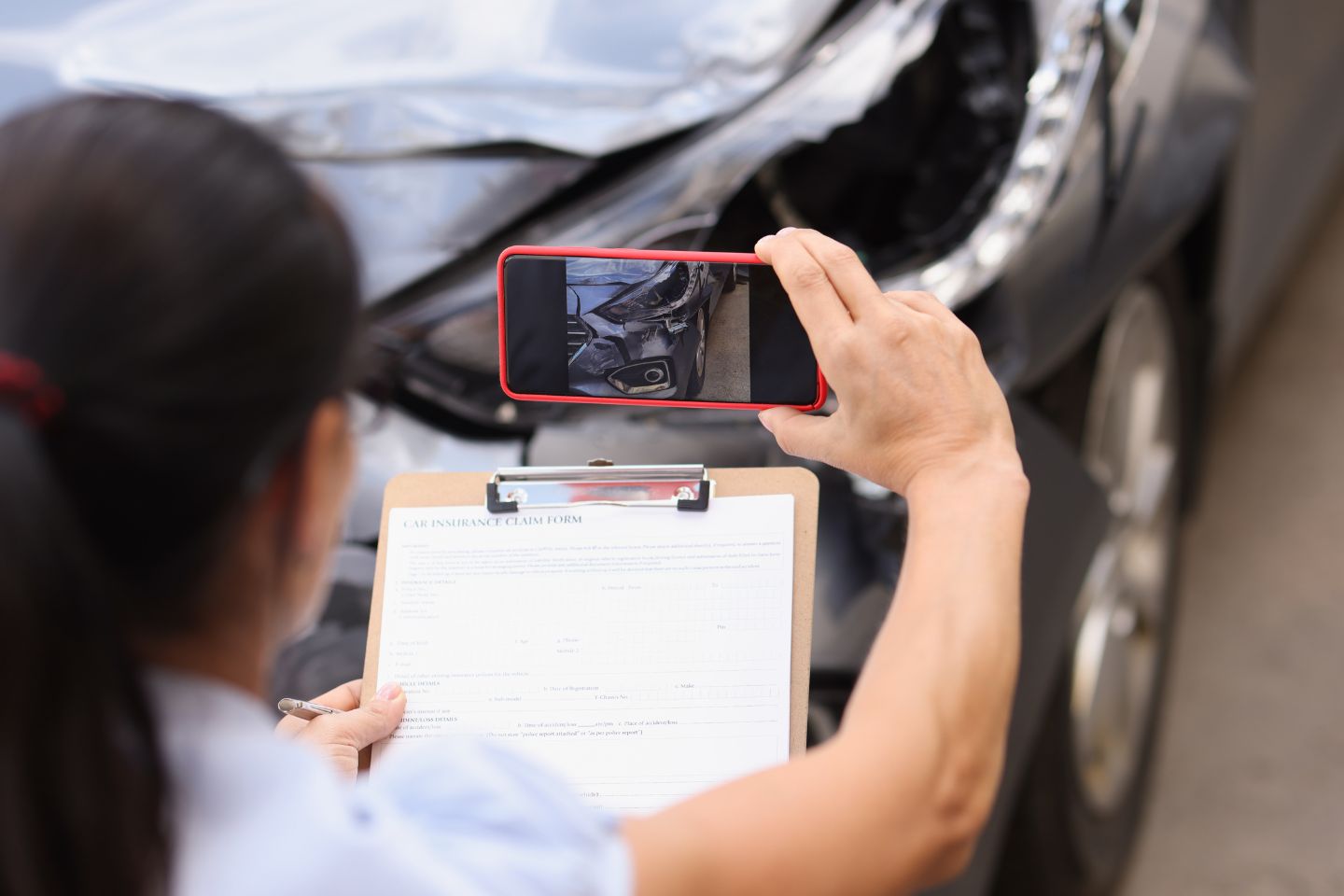

Seeking Justice After a Car Accident? The Personal Injury Center Can Help
Navigating the aftermath of a Santa Maria car accident can be overwhelming, but you don’t have to face it alone. The Personal Injury Center specializes in providing essential support and guidance during these challenging times.
We are dedicated to educating and empowering individuals affected by car accidents by linking them with proficient lawyers, who are well-versed in navigating such cases. These legal experts provide personalized assistance tailored to your specific needs so you can confidently navigate the legal landscape.
| Key Takeaways
|



